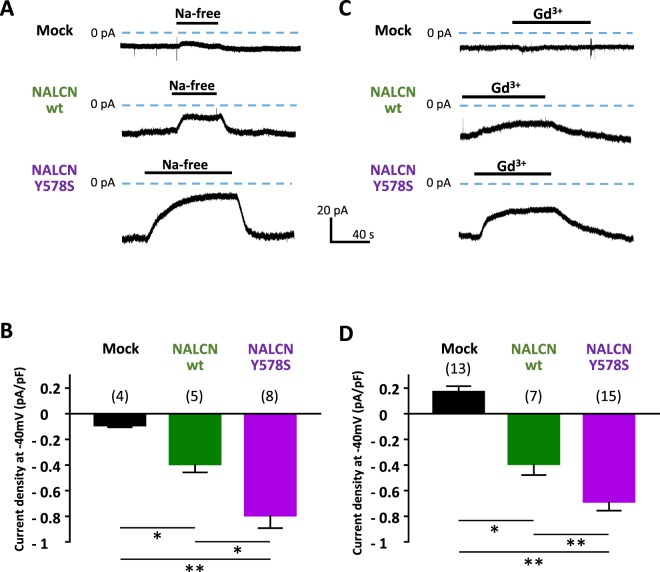Figure 2.
Transient expression of the wild-type (wt) NALCN and its CLIFAHDD variant Y578S together with NLF1 in differentiated NG108-15 cells results in the expression of a NMDG- and Gd3+-sensitive background Na+ current. (A) Representative traces obtained on cells held at −40 mV (HP) during application/wash of an extracellular Na+-free solution (replaced with NMDG) for a mock (NLF1)-transfected cell (top), a NALCN/NLF1 (wt)-transfected cell (middle), a NALCN CLIFAHDD mutant (Y578S)/NLF1-transfected cell (bottom). (B) Density of the external Na+-dependent background current (Na+-free) for mock-transfected cells (−0.088 ± 0.03 pA/pF, n = 4); NALCN: −0.391 ± 0.14 pA/pF, n = 5; NALCN-Y578S: −0.79 ± 0.32 pA/pF, n = 8). (C) Representative traces obtained on cells held at −40 mV during application/wash of Gd3+ (10 µM) for a mock-transfected cell (top), a NALCN (wt)-transfected cell (middle), a NALCN CLIFAHDD mutant (Y578S)-transfected cell (bottom). (D) Average density of the Gd3+-sensitive background current for mock-transfected cells (0.168 ± 0.16 pA/pF, n = 13), NALCN (wt)-transfected cells (−0,391 ± 0.23 pA/pF, n = 7) and NALCN-Y578S-transfected cells (−0.684 ± 0.27 pA/pF, n = 15). Both the Na+-dependent background current and the Gd3+-sensitive background current were significantly of higher density for wt NALCN and its pathogenic variant Y758S compared to the control condition (p = 0,03 and 0,004 for the Na+-dependent component and P < 0.0001 and <0.0001 for the Gd3+-sensitive component respectively). In addition, densities of the Na+-dependent background current and the Gd3+-sensitive background current were significantly lower for wt NALCN compared to its pathogenic variant Y578S (p = 0.045 and p = 0.029 respectively). p values were calculated with a Mann-Whitney statistical test.

